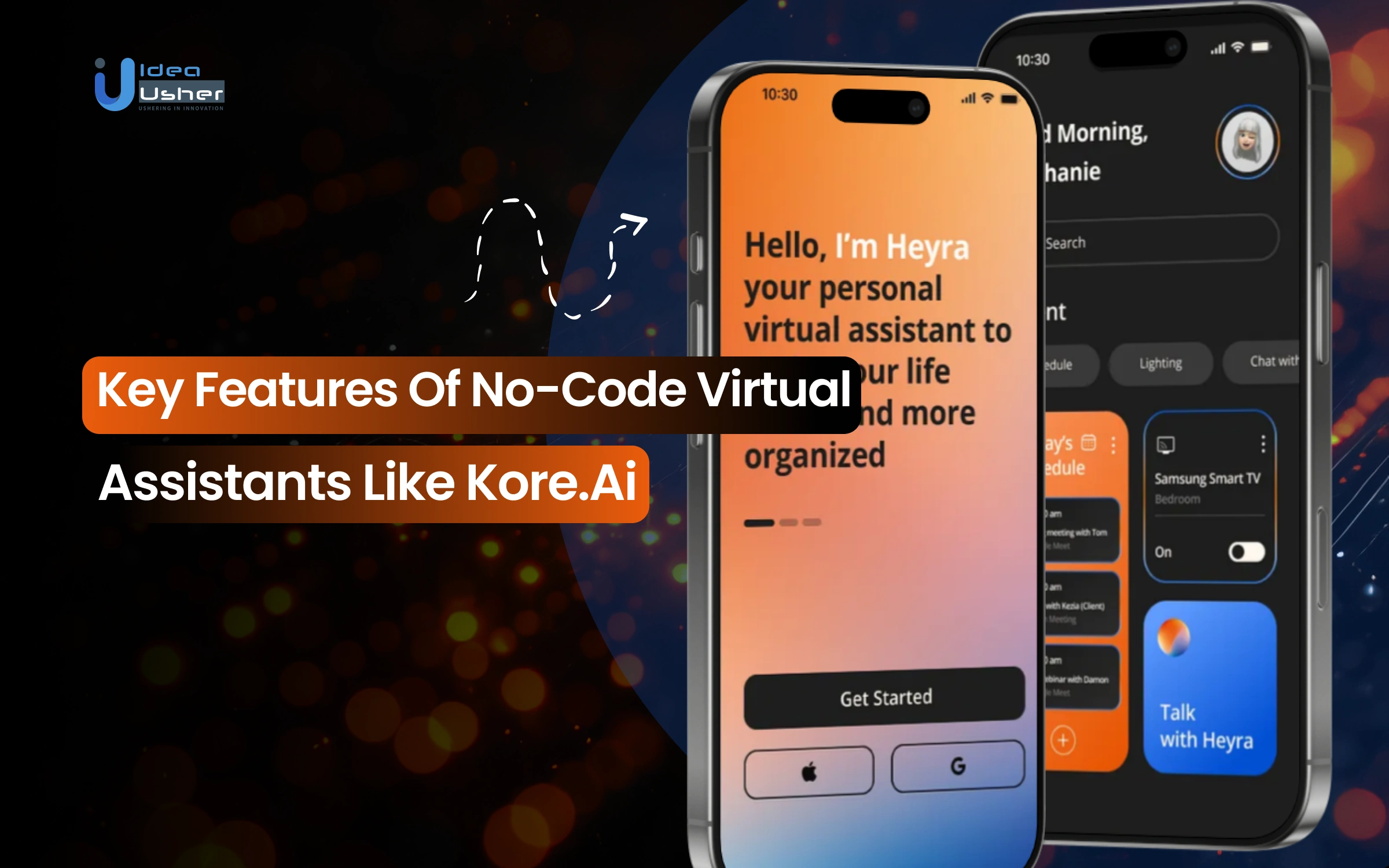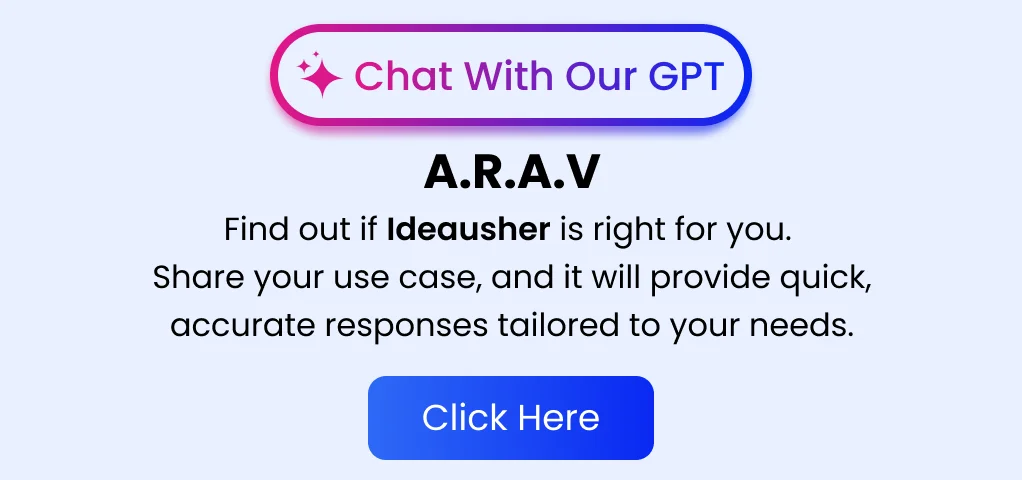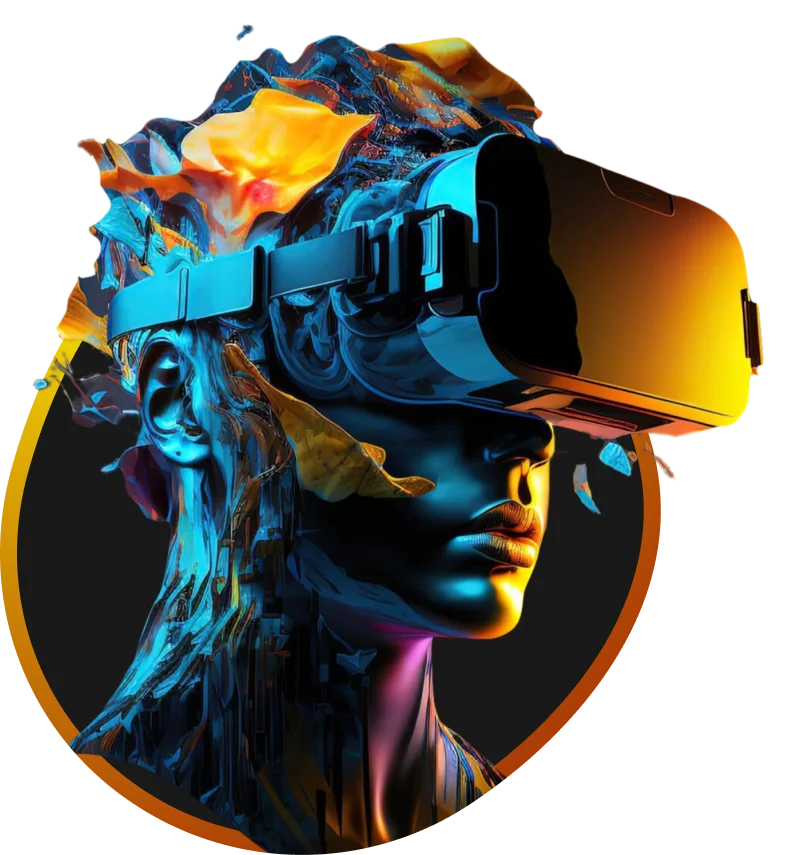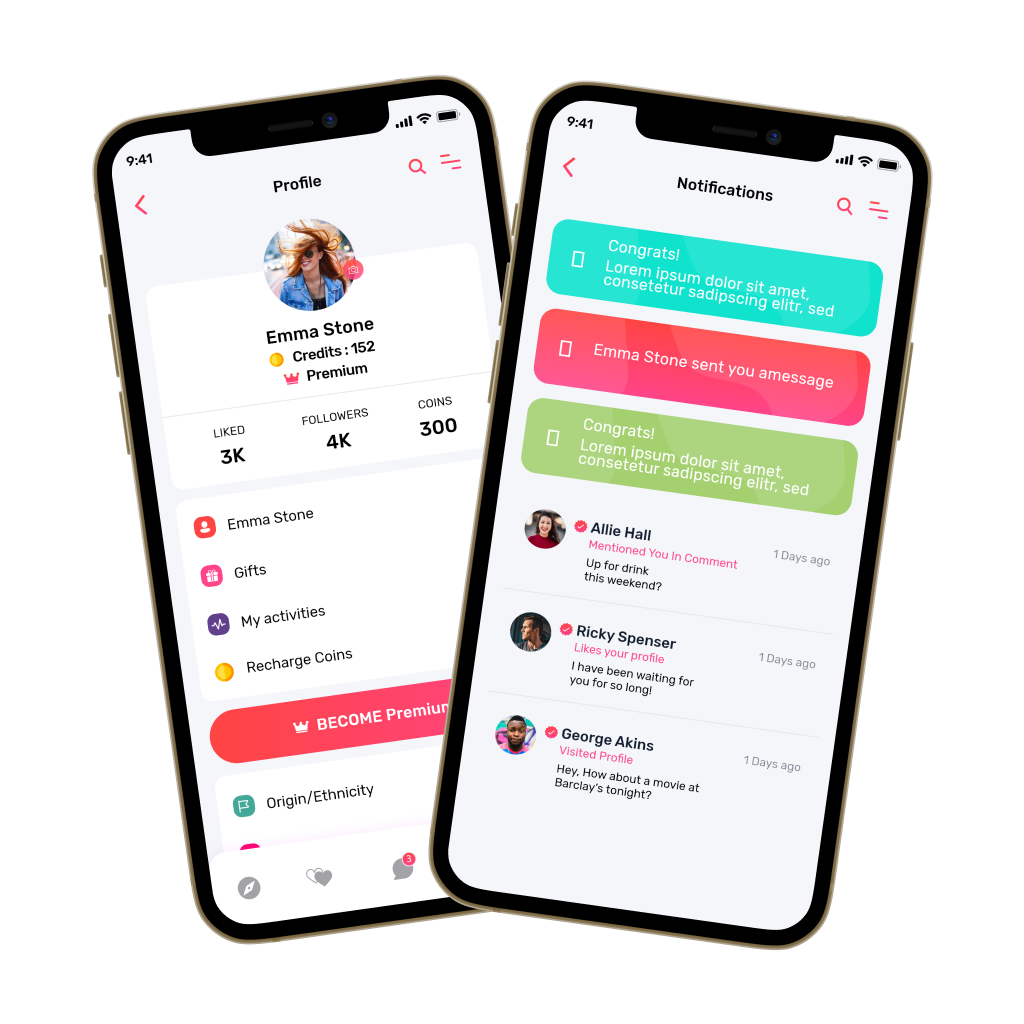Every business today wants to offer quick, human-like conversations without relying on spending months building and coding chatbots from scratch. They are looking for solutions that adapt quickly and allow non-developers to create smart, conversational experiences without any coding. The idea of a No-Code Virtual Assistant changes that, giving teams the freedom to design, test, and launch conversational experiences with the same ease as editing a slide deck.
Platforms like Kore.ai are at the forefront of this change, helping businesses create AI-powered assistants with visual flows, drag-and-drop tools, and easy-to-use dashboards. These platforms make advanced technology more accessible, so even teams without technical backgrounds can design smart, natural conversations that boost efficiency and engagement.
In this blog, we’ll explore the key features of No-Code Virtual Assistants like Kore.ai, uncovering how they simplify development, accelerate automation, and open new possibilities for businesses ready to embrace AI without the complexity of code. With our experience building AI solutions across industries, IdeaUsher can build no-code virtual assistants for businesses that want to enhance customer experience, reduce operational costs, and deploy AI-powered automation quickly and efficiently without technical barriers.
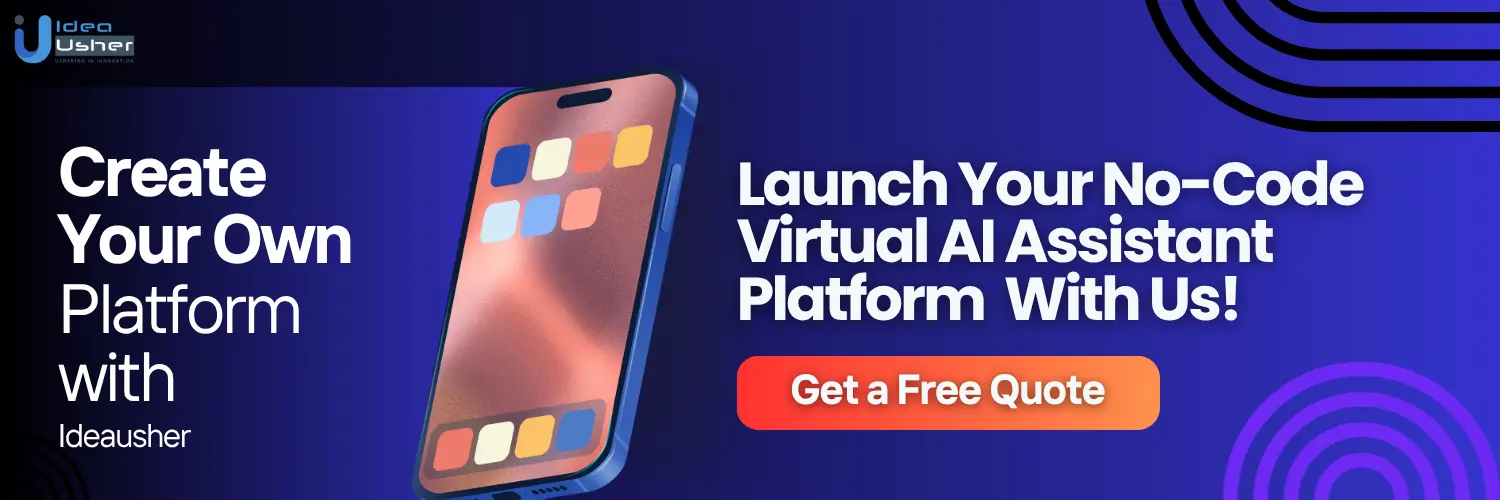
What is Kore.ai?
Kore.ai is an enterprise-grade conversational AI platform that enables organizations to build, deploy, and manage intelligent virtual assistants (VAs) and chatbots across voice and digital channels. Designed for both customer-facing and employee-facing use cases, it helps automate interactions, improve user experience, and drive operational efficiency.
Its no-code/low-code platform lets businesses create AI virtual assistants without technical expertise. With robust NLP, multilingual support, and CRM, ERP, and ITSM integrations, these are some of the key aspects of Kore.ai that enable human-like conversations across websites, apps, and messaging.
- Visual Drag-and-Drop Designer: Kore.ai’s interface lets users build conversational flows with drag-and-drop, no coding needed.
- Pre-Built Templates: Ready templates and industry models enable faster bot deployment and customization.
- Advanced NLP & ML: Kore.ai’s technology manages language, context, and intent, allowing you to focus on designing your assistant instead of dealing with AI details.
- Omnichannel Publishing: User can launch assistants on chat, voice, web, and mobile platforms without any extra development work.
- Enterprise Integrations: Connect assistants to databases, CRMs, ERPs, or workflows to fetch data and perform real tasks.
Business Model
Kore.ai is an enterprise software company providing conversational AI, virtual assistants, and chatbots for large and mid-sized organizations across banking, healthcare, telecom, and employee services. The business model can be summarised as:
- Kore.ai offers the XO Platform, a no-code/low-code toolset and enterprise integrations for building, deploying, and managing virtual assistants across voice and digital channels.
- It targets enterprises with high value, long sales cycles, customization, and integration, also using partner channels for global expansion.
- This platform also serves smaller customers / SMBs / developers via self-service/pay-as-you-go models (for simpler usages) which helps broaden adoption.
- It emphasises vertical-specific solutions (pre-built assistant templates for industries and functions) which help reduce time-to-value and raise adoption.
- Kore.ai highlights recurring revenue from software subscriptions/licenses, professional services, and usage-based metrics, depending on the plan.
Revenue Model / Streams
Here are the major revenue streams that Kore.ai uses:
- Software Subscriptions / Licensing: Kore.ai earns most revenue from subscriptions, with pricing based on features, scale, and usage. A pay-as-you-go option is available for smaller users.
- Professional / Implementation Services: Professional services cover bot design, system integration, NLP training, and support for custom enterprise deployments. Usually project-based, they generate non-recurring or semi-recurring revenue.
- Usage / Interaction-Based Pricing: Usage-based pricing charges for interactions, users, channels, or bot complexity. As adoption grows, so does revenue, creating upsell opportunities.
- Vertical / Industry Solutions & Templates: Industry-specific templates for banking, healthcare, HR, and IT accelerate deployment and add business value. They may come with subscriptions or as premium add-ons.
How Does Kore.ai Work?
Kore.ai’s No-Code Virtual Assistant Platform, the Kore.ai XO Platform, enables businesses to build, train, test, and deploy conversational assistants without coding. It integrates NLU, ML, and automation in a visual, drag-and-drop interface. Below is a step-by-step breakdown of how Kore.ai’s no-code virtual assistant workflow works.
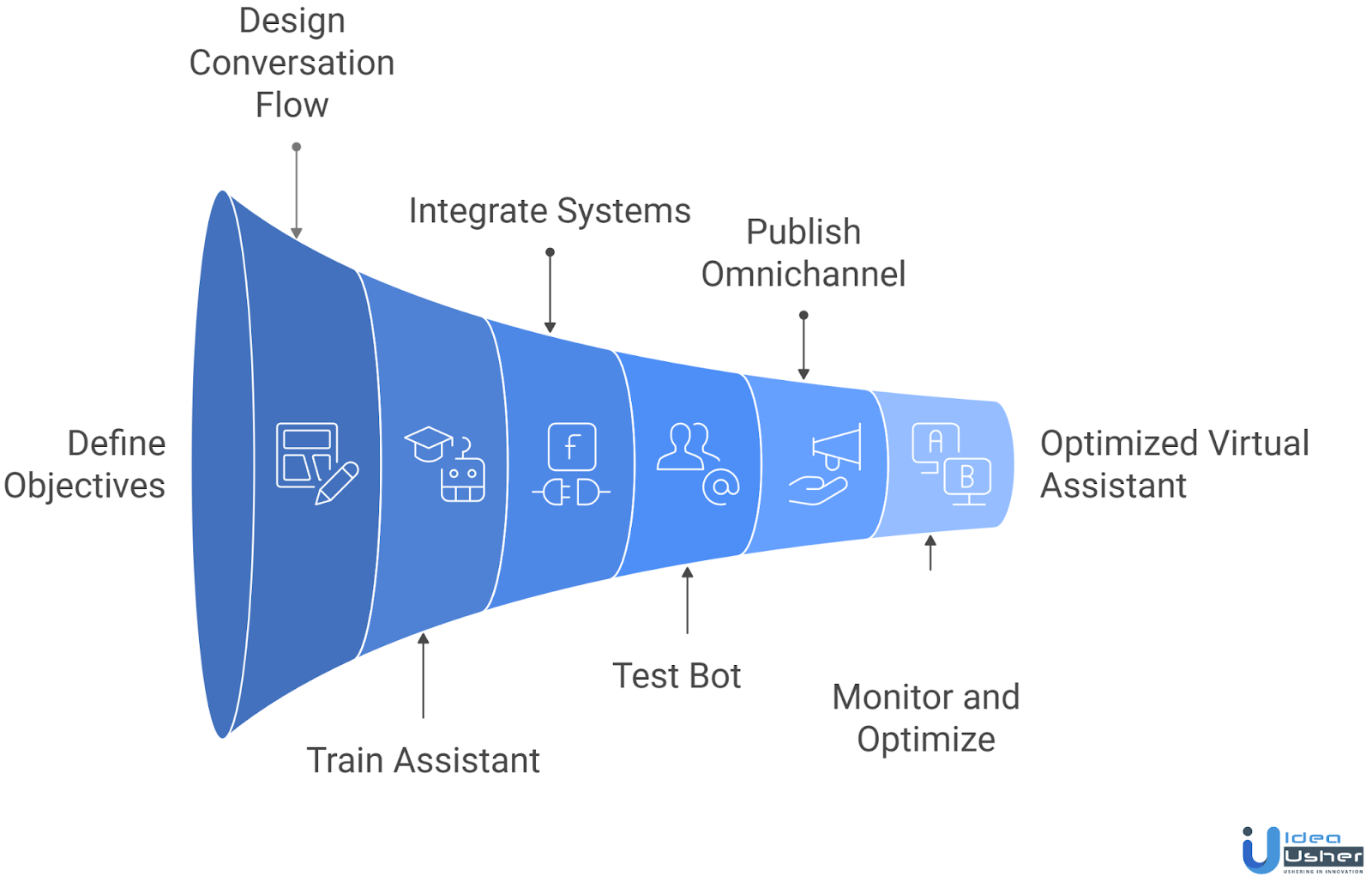
1. Define Objectives & Use Cases
The first step is to determine what you want your virtual assistant to do. This could be automating customer support queries, assisting employees with HR or IT requests, or guiding users through a purchase or service process.
In Kore.ai, you begin by defining:
- Use-case goals (e.g., resolve customer issues, collect data, process orders)
- Target audience (customers, employees, partners)
- Preferred channels (web, mobile app, WhatsApp, IVR, etc.)
Once defined, the user can create a new virtual assistant within the platform.
2. Design the Conversation Flow (No-Code Builder)
Next, users move into the Visual Conversation Designer, a drag-and-drop interface that lets you build dialogue flows, essentially how the assistant talks to users.
- It can visually map each step of a conversation (greetings, questions, actions, responses).
- The interface allows you to add intents, entities, and context variables simply by selecting components.
- The user can also define fallback paths, confirmation messages, and handoff points for human agents.
Example: To create a flow for “Check Account Balance,” simply drag an “Intent Node,” define expected phrases like “Check my balance” or “Show account details”, and connect it to an API integration that retrieves balance information.
3. Train the Assistant (NLP & ML Models)
Once conversation flows are built, the assistant needs to understand human language. Kore.ai automatically handles this with its built-in NLP engine, which supports:
- Intent Recognition: Understanding what the user wants based on their phrasing.
- Entity Extraction: Identifying key data points like names, dates, amounts, etc.
- Context Handling: Maintaining the state of the conversation (so it feels natural and contextual).
The platform includes pre-trained language models and industry templates, meaning it can recognize domain-specific language out of the box (e.g., “track order,” “reset password,” “open a ticket”).
Training works by using examples. The user just gives some sample phrases, and the platform’s machine learning engine figures out how to handle similar cases.
4. Integrate with Backend Systems
To make the assistant do real work, Kore.ai allows integration with enterprise systems and APIs.
Using the Integration Designer, users can connect to:
- CRM systems (e.g., Salesforce, HubSpot)
- ERP systems (e.g., SAP, Oracle)
- ITSM tools (e.g., ServiceNow, Jira)
- Databases, payment gateways, or proprietary APIs
These integrations enable the assistant to perform actions like:
- Fetching data
- Creating or updating records
- Processing transactions
- Running workflows
These integrations are set up through no-code connectors and configuration wizards rather than complex programming.
5. Bot Testing Studio
Before going live, Kore.ai offers a testing environment that simulates real user interactions.
Here you can:
- Test intent recognition accuracy
- Debug dialogue flows
- View context tracking and variable values
- Monitor fallback responses
The testing suite provides visual analytics and suggestions to help improve accuracy and conversational quality.
6. Omnichannel Publishing
Once tested, the assistant can be published across multiple channels instantly, without any separate development work.
Kore.ai supports 100+ digital and voice channels, including:
- Web chat widgets
- Mobile apps (iOS/Android SDKs)
- WhatsApp, Facebook Messenger, Microsoft Teams, Slack
- Voice/IVR systems (Amazon Connect, Twilio, Genesys, etc.)
Companies can manage all channels from a single unified dashboard, ensuring consistent behavior and branding across platforms.
7. Monitor, Analyze, and Optimize
After deployment, Kore.ai’s Analytics Dashboard tracks performance metrics in real time.
It measures:
- Intent recognition accuracy
- User satisfaction scores
- Containment rates (how many queries are handled by the bot)
- Escalations to live agents
- Channel usage and peak activity times
The analytics tools use these insights to suggest improvements, allowing teams to continuously train, refine, and optimize the assistant’s performance.
Industry Use Cases Where No-Code AI Bots Deliver Impact
No-code virtual assistant like kore.ai revolutionize industries by making automation accessible to non-technical teams. They streamline workflows, boost productivity, and improve customer engagement. Below are key sectors where no-code AI assistants create impact.
1. Banking & Financial Services
No-code bots automate customer interactions, streamline KYC processes, and handle loan or policy inquiries effortlessly. They enable 24/7 support while maintaining compliance and security through integrated verification systems.
Example: Kore.ai’s virtual assistant helped a leading U.S. bank automate 70% of inbound queries, cutting average handling time by 40% and improving first-contact resolution.
2. Healthcare
AI bots help healthcare providers manage patient engagement, automate appointment scheduling, and handle billing or insurance queries securely. Integration with EHR systems ensures seamless data flow and compliance with HIPAA or equivalent standards.
Example: A major healthcare provider using Kore.ai’s platform improved patient engagement rates by 55% and reduced scheduling time by 30%.
3. Retail & E-Commerce
Retailers use no-code bots to deliver personalized shopping experiences, guide customers through product discovery, and handle returns or shipping updates automatically. They enhance conversions through intelligent upselling and cross-selling prompts.
Example: Kore.ai’s e-commerce assistant helped a global retailer increase repeat purchases by 25% and reduce cart abandonment with proactive engagement.
4. Travel & Hospitality
In travel and hospitality, no-code bots manage booking queries, cancellations, loyalty programs, and flight or hotel updates. They also provide multilingual support to cater to global travelers.
Example: A travel management firm used Kore.ai’s conversational AI to automate itinerary updates, reducing manual agent intervention by 60%.
5. Insurance
AI-driven no-code bots simplify claims processing, premium calculations, and policy renewals through conversational workflows. They improve customer trust through transparency and instant support.
Example: Kore.ai’s insurance assistant enabled a top insurer to process claims 40% faster and improve NPS scores by 20 points.
6. Education & E-Learning
Educational institutions use AI bots for student onboarding, admissions, and 24/7 academic support. These bots can assist with FAQs, class schedules, and assignment deadlines while maintaining engagement.
Example: A university leveraging Kore.ai’s platform automated over 65% of student service requests, enhancing satisfaction and freeing staff for academic support.
7. Human Resources & Recruitment
No-code bots assist HR teams by automating employee onboarding, answering policy queries, and scheduling interviews. This frees up HR professionals to focus on strategic initiatives like talent engagement.
Example: A company can use a no-code assistant to collect candidate details, schedule interviews, and update applicants about their hiring status, improving transparency and efficiency.
8. Customer Support & Service Centers
AI bots serve as the first line of support, resolving FAQs, routing tickets, and collecting feedback. They ensure faster response times and consistent service quality without overburdening human agents.
Example: Kore.ai helped a telecom operator automate over 50% of Tier-1 support tasks, improving response speed and cutting operational costs by 35%.

How 79% of Businesses Boost Efficiency with AI Voice Assistants?
The no-code AI platform market was USD 3.83 billion in 2023 and is projected to reach USD 24.42 billion by 2030, growing at a 30.6% CAGR from 2024 to 2030. This indicates worldwide adoption of low-code and no-code solutions for AI development in voice assistants, automation, and customer engagement.
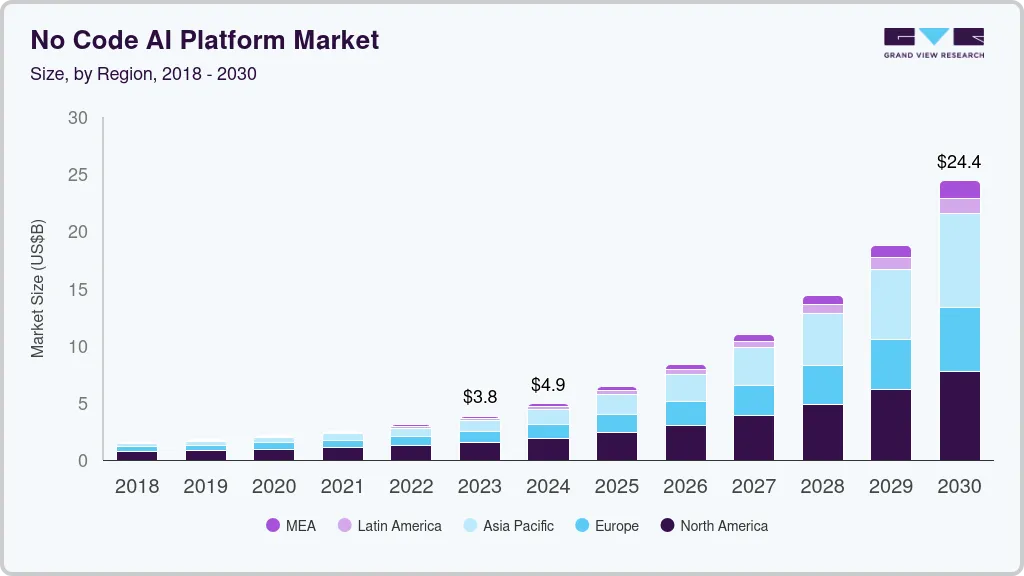
The 2025 PwC AI Agent Survey shows that 88% of U.S. executives plan to increase AI-related budgets in the next year, with 79% already adopting agentic or voice AI automation. Among these organizations:
- 57% are using or planning to use AI agents for customer service
- 54% in sales and marketing
- 53% in IT and cybersecurity
Even more notably, 66% of business leaders reported measurable productivity gains, while 48% said overall headcount is expected to increase due to higher productivity and expanded business capabilities.
These statistics show that enterprises are integrating AI voice assistants not just as tools, but as enablers of growth, revenue, and workforce augmentation.
The Growing Market for No-Code AI Voice Assistants
The AI voice assistant market was valued at $33.47 billion in 2024 and is projected to reach $104.37 billion by 2032, with a 15% CAGR. At the same time, the no-code AI movement itself is accelerating:
- Tools like PyCaret, DataRobot, and Rasa Studio now account for 25% of all new enterprise AI deployments (2024).
- Voiceflow and SmatBot reported a 60–80% reduction in deployment time for AI voice assistants compared to traditional methods.
- Businesses can now deploy fully functional voice flows using visual builders, enabling faster iteration cycles and real-time updates without coding dependencies.
This growth reflects not just cost efficiency but a cultural shift toward “citizen development”, where product managers, marketers, and CX professionals can build and manage AI-driven interactions directly.
Kore.AI Leading the No-Code Voice Revolution
According to Forrester’s Conversational AI for Customer Service Report (Q2 2024), Kore.AI was named a Leader for its strengths in voice support, business insights, and platform vision.
Kore.AI’s ecosystem reveals a balanced mix of enterprise clients:
- 48% large enterprises (>$1 billion revenue)
- 33% small businesses (<$50 million)
- 19% startups and SMEs with fewer than 50 employees
The platform’s client distribution underscores its versatility. Around 38% of Kore.AI’s users come from IT services, followed by 8% from computer software and 7% from financial services, with 60% of users based in the U.S. and 9% in India.
This adoption pattern shows how enterprises across industries are choosing no-code solutions to reduce development time, increase agility, and optimize customer interaction without depending on large engineering teams.
Real-World Case Studies: Efficiency in Action
Vodafone Germany (2025) integrated Google Cloud’s voice AI and achieved:
- 40% of customer service calls are handled autonomously
- 20% faster resolution times for human agents
- Improved customer satisfaction and lower operational costs
Similarly, a U.S.-based HVAC company using Vapi.ai’s AI phone agent reported:
- $20,000 in saved revenue within 30 days
- 20% higher booking rates in the first week
- 24/7 lead handling, reducing missed opportunities
These case studies show a clear trend. AI voice assistants have moved beyond the experimental stage and now play a direct role in improving profitability, efficiency, and customer retention in many industries.
The Road Ahead: No-Code, Multi-Modal, and Scalable
McKinsey’s Conversational AI Outlook 2025 reveals that 78% of companies now deploy Conversational AI in at least one operational area, with most reporting “steady returns” and “improved efficiency.” Meanwhile, 70% of tech and CX leaders have already invested in AI bots, anticipating near-universal adoption within the next few years.
As no-code AI platforms improve, businesses will see faster deployment, better analytics integration, and conversational systems that bring together voice, chat, and visual features. All of this can happen without the need for complicated engineering.
Key Features of No-Code Virtual Assistant Like Kore.ai
A no-code virtual assistant platform like Kore.ai empowers businesses to deploy intelligent, automated customer interactions without any coding expertise. It streamlines bot development, integrates seamlessly with enterprise systems, and enhances user experience through advanced AI capabilities.
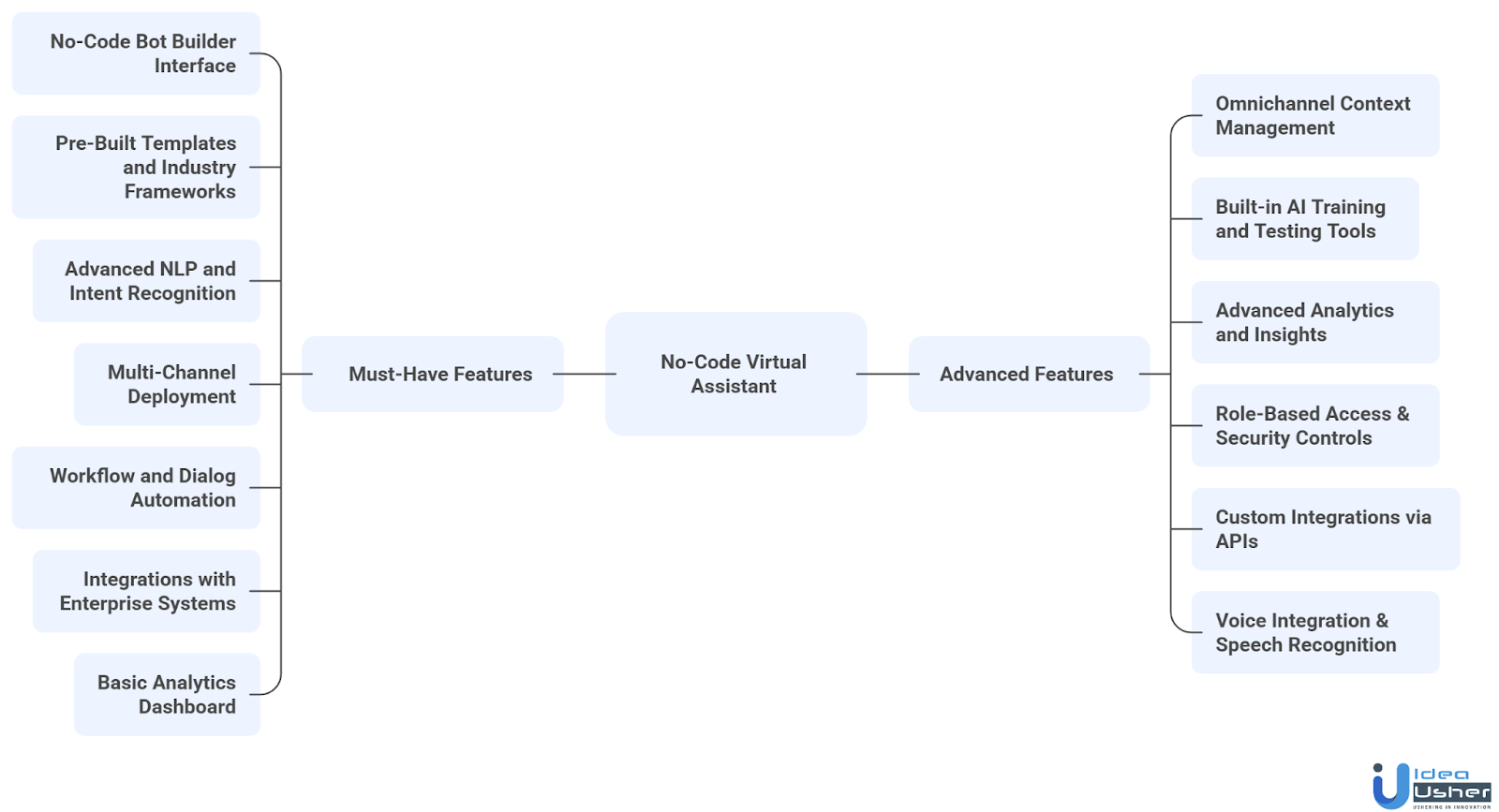
A. Must-Have Features for MVP Launch
A minimum viable virtual assistant should focus on the main features that make it easy to use, able to grow, and efficient. This approach helps businesses launch a working product quickly and see how the market responds.
1. No-Code Bot Builder Interface
A no-code visual builder enables non-technical teams to quickly create and customize virtual assistants with drag-and-drop tools, accelerating deployment, reducing developer reliance, and speeding up time-to-market.
Example: A retail company can design a product recommendation assistant within hours to improve customer engagement without involving a development team.
2. Pre-Built Templates & Industry Frameworks
Industry-specific templates simplify deployment for sectors like finance, healthcare, and e-commerce. They come with pre-defined conversational flows that meet compliance and domain standards, saving time and ensuring reliable results.
Example: A bank can deploy a customer support assistant using a finance template that already includes FAQs on loans, KYC, and card management.
3. Advanced NLP & Intent Recognition
Natural Language Processing (NLP) allows the assistant to understand slang, tone, and context, delivering human-like responses. This boosts user satisfaction, reduces friction, and builds trust through accurate, contextual replies.
Example: A healthcare chatbot can recognize variations of appointment requests (“book a doctor,” “see a physician,” “need a checkup”) and respond accurately every time.
4. Multi-Channel Deployment
Users can connect through websites, mobile apps, WhatsApp, or social media, all using the same assistant. This wide availability makes it easier for people to access, stay consistent, and stay engaged wherever they are.
Example: A travel agency’s assistant can help users get flight updates through WhatsApp, website chat, or email, making support easy across all channels.
5. Workflow and Dialog Automation
Automates routine processes like scheduling, ticket creation, or lead capture, freeing up human agents for higher-value tasks. It directly improves operational efficiency and customer service response times.
Example: A hospital can automate appointment scheduling and reminders, freeing up staff time and reducing no-show rates.
6. Integrations with Enterprise Systems
Integrating CRMs, ERPs, and ticketing systems allows the assistant to fetch real-time data for contextual answers. This ensures seamless workflow automation and better user experiences.
Example: A sales assistant integrated with CRM can update client data, track leads, and notify the team automatically after each interaction.
7. Basic Analytics Dashboard
Provides actionable insights into user queries, engagement patterns, and success rates. Businesses can use this data to improve conversation design and optimize performance over time.
Example: A customer service team can analyze which questions users ask most frequently and improve automation coverage in future updates.

B. Advanced Features (Post-MVP Considerations)
Once the MVP demonstrates value and adoption, businesses can enhance their assistant with intelligent, scalable, and enterprise-grade capabilities to strengthen automation and personalization.
1. Omnichannel Context Management
Allows users to start a conversation on one channel (like web chat) and continue seamlessly on another (like WhatsApp). This Kore.ai like features enhance customer satisfaction and boost engagement through consistent, uninterrupted experiences.
Example: A user can begin a support query on the company website and continue the same conversation via mobile app later without repeating information.
2. Built-in AI Training and Testing Tools
Continuously improves performance by learning from real user interactions. Automated retraining helps reduce errors, keep dialogues up to date, and maintain conversational accuracy at scale.
Example: The assistant automatically picks up new phrases that customers use over time, such as trending product names or slang. This helps it respond more effectively.
3. Advanced Analytics and Insights
Gives deep visibility into user sentiment, conversion metrics, and operational impact. With predictive insights, for this Kore.ai like features, businesses can make data-backed improvements and demonstrate ROI.
Example: An insurance company can track how many policy queries were resolved automatically and how that impacts agent workload.
4. Role-Based Access & Security Controls
Ensures data privacy and governance by defining roles and permissions within the system. This Kore.ai like features prevents unauthorized access and maintains compliance with security frameworks like GDPR and HIPAA.
Example: A financial institution can restrict access so that only compliance officers can modify regulatory conversation flows.
5. Custom Integrations via APIs
Allows teams to connect external tools, enabling workflow expansion without altering the core platform. This flexibility supports long-term scalability and custom use cases.
Example: An HR department can integrate the assistant with payroll software to provide employees with instant salary or leave updates.
6. Voice Integration & Speech Recognition
It goes beyond chat by supporting voice-based conversations, making it useful for call centers, mobile apps, and IoT devices. This Kore.ai like features makes the technology more accessible and improves the experience for people who prefer using their voice.
Example: A logistics company can enable drivers to report delivery status through voice input while keeping their hands free on the road.
How IdeaUsher Will Help You Build a No-Code Virtual Assistant Platform?
At IdeaUsher, we build enterprise AI and no-code automation platforms that enable businesses to deploy virtual assistants quickly and at scale. We combine AI, UX, and backend engineering to create platforms as dynamic as Kore.AI.
1. Consultation
We start by identifying your target audience, goals, and use cases like customer support or workflow automation. Our solution architects then design a modular, no-code platform for easy assistant creation and scalability.
2. No-Code Interface & Flow Builder Development
Our developers create an intuitive drag-and-drop interface enabling users to build conversational flows without technical knowledge. It supports intent mapping, conditional logic, and prebuilt templates for easy bot creation and customization.
3. AI Model Integration & Training
We integrate NLU, Generative AI, and context-aware intent detection to enable virtual assistants to understand dialogues, emotions, and user patterns, providing human-like conversations.
4. Omnichannel Deployment & API Integration
Our engineers connect your no-code platform to web, mobile, social, and voice channels for seamless interactions. They also integrate enterprise APIs like CRMs, ERPs, and ticketing systems, enabling assistants to handle tasks like booking, payments, and data retrieval.
5. Continuous Optimization
We embed real-time analytics dashboards to track conversation performance, sentiment, and automation success. Continuous learning modules enhance bot accuracy and responsiveness, helping your platform adapt to user behavior and business needs.
6. Deployment
Before launch, our team implements enterprise security measures like data encryption, role-based access control, and GDPR compliance. After validation, we deploy your no-code platform in a cloud or hybrid environment for scalability and reliability.
7. Post-Launch Support
After deployment, we offer continuous monitoring, model tuning, and feature upgrades to keep your virtual assistant platform competitive. As your business expands, we assist in scaling the system for more assistants, advanced integrations, and multilingual support.
Estimated Cost to Build a No-Code Virtual Assistant
The cost of developing a no-code virtual assistant platform Kore.ai like features varies based on project scale, features, AI integrations, and customization. Here’s a cost breakdown by development phase to estimate the investment for a full-scale platform.
| Development Phase | Description | Estimated Cost |
| Consultation | Market research, use-case analysis, and system architecture planning | $5,000 – $10,000 |
| UI/UX & No-Code Builder Development | Building a drag-and-drop interface for flows and templates. | $12,000 – $20,000 |
| AI Model Integration & Training | Integrating NLP, LLMs, and intent recognition models to enhance conversational accuracy. | $15,000 – $30,000 |
| API & Channel Integrations | Connecting the platform with CRMs, ERPs, payment systems, and communication channels. | $8,000 – $15,000 |
| Analytics Dashboard & Reporting | performance tracking, conversation metrics, and data visualization dashboards. | $6,000 – $10,000 |
| Security & Compliance Implementation | Ensuring GDPR compliance and enterprise-grade security. | $5,000 – $8,000 |
| Testing & Deployment | Testing, then deployment on cloud or hybrid environments. | $4,000 – $7,000 |
| Post-Launch Maintenance | Continuous updates, bug fixes, AI retraining, and integration of advanced features. | $2,000 – $5,000/month |
Total Estimated Cost: $62,000 – $130,000
Consult with IdeaUsher to receive a customized estimate tailored to your product vision and business goals for your No-Code Virtual Assistant Platform.
Conclusion
The growing demand for intelligent automation is pushing more businesses to adopt No-Code Virtual Assistants Like Kore.ai. Their ability to simplify development, automate workflows, and deliver contextual support makes them an effective investment for improving customer and employee experiences. With Kore.ai like features such as drag and drop intent design, integration flexibility, and advanced conversational capabilities, these assistants help organizations scale faster while reducing operational load. Choosing the right platform and designing a clear implementation strategy can ensure long-term value as automation continues to evolve.
Work with Ex-MAANG developers to build next-gen apps schedule your consultation now
FAQs
No-code virtual assistants eliminate the need for complex programming, helping teams build and deploy automation faster. They offer easy configuration through drag and drop tools, which reduces development cycles and lowers operational costs without compromising performance or intelligence.
They allow businesses to design conversational flows tailored to real customer behavior. Built in NLP, sentiment detection, and channel integration help create interactions that feel natural, quick, and helpful, which strengthens customer satisfaction and retention.
Yes. Modern platforms support scalability, workflow automation, system integrations, and secure data handling. They can manage advanced operations such as service requests, appointment scheduling, and internal support while maintaining compliance and performance standards.
They allow business users and product teams to build and refine assistants directly. Technical experts still support integration and advanced logic, but the overall reliance is reduced, enabling faster improvements and more control over updates.
